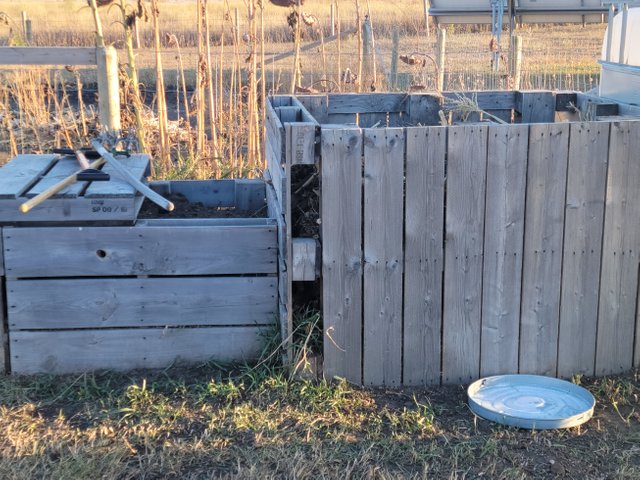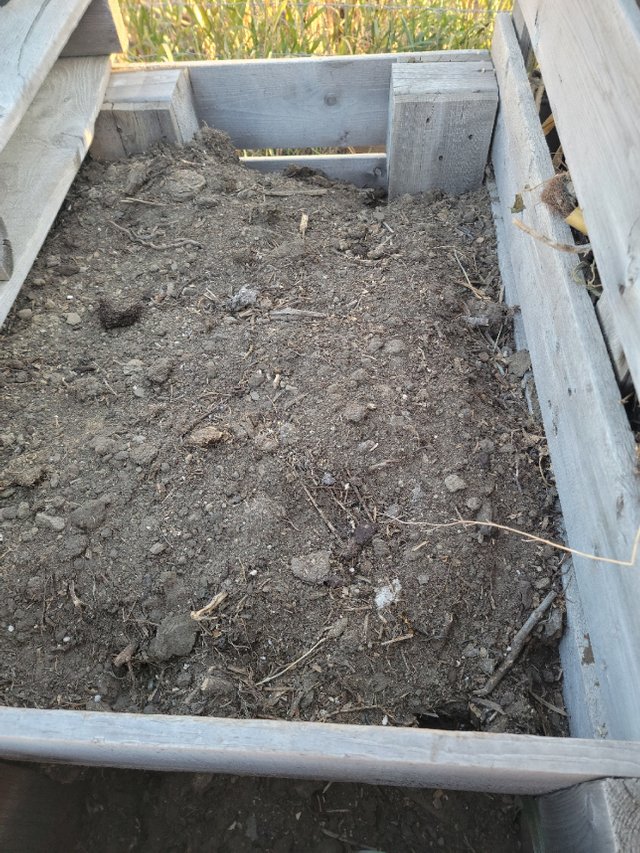The Compost Bins #club100
Composting is an important gardening activity. If you want nutritious vegetables to grow in your vegetable plot, you better be sure to replace the nutrients you take out.

This is my compost bin system. One big bin for raw materials and one small bin for finished compost. Every couple of months, I harvest finished compost from the big bin. Then I spread the compost around on my garden beds.
I throw all organic waste into the big compost bin. Except meat and meat products. Don't throw those in there. Except egg shells. Throw all the egg shells in there that you have. In general, all vegetable peels, fruit peels, leftovers, scraps, eggshells, grass clippings, weeds, dead plant material, sticks, and manure all get thrown into the big bin where it breaks down to become compost.

Here is the top of the big bin. What you cant see is the layers underneath. Green matter, like vegetable peels, grass clippings and fresh manure, are layered between brown matter (sticks, dead leaves, sawdust).
You need twice as much brown as green matter or a ratio of 2:1.
Once you have a layered your bin, throw some dirt or older compost on the top. This helps protect your bin from drying out.
The next thing you will need is air and water. My compost bins have spaces between the boards that ensures all layers have access to fresh air. If it has been raining, you are lucky, but if you are experiencing drought, you will need to add some water. You can add water when assembling the layers, but if it is really dry out, you will need to add water from your garden hose.

These ingredients, the browns, the greens, air, and water, work together to reduce your waste into compost. Actually, it is micro-organisms that do all the work. The compost ingredients only provide a habitat for microorganisms to live in. These microorganisms heat and break down the wastes into nutrient rich soil.
The small bin is my finished product that I will add to my garden beds when I have the opportunity.
An interesting thing about composting is that the volume of finished product is much smaller than the huge pile I start out with. Right now my big bin is about 3/4 full, but it is normal for my pile to extend several feet above the top of the bin. As the microorganisms do their work, the contents of the bin shrink. So each time I harvest the big bin, what I get is an amount that fills the little bin.
The best time to add compost to your garden is in both Spring and Fall. I am going to use the small bin on my garden now before Winter starts, and then by Spring, the contents of the large bin will be ready. So once I start preparing the soil for planting in the Spring, I will add even more compost.
This is a 100% #steemexclusive POWER UP! post for #club100
Your compost pit is made of pallets! class.
Hmm. But you have almost only sand there.
Yes, pallets are very handy for making compost bins. It is like they were designed to serve this purpose.
What do you mean that I only have sand? Perhaps you are observing the dryness of the top layer? The drought here is very severe and the outside layer of the compost pile has the moisture sucked right out of it. Due to the pressure of the drought, I need to add water frequently. This is year 9 of the drought.
Try to cover it with a film after adding water to this pile. It will restrain the evaporation of water.
Well sure, but did you want to see a picture of a tarp? I have a layer of dirt over the top to protect the interior layers and on top of that is the tarp--depending on the weather forecast. Sometimes I want the rain to land directly on the compost.
😂😂😂👌
Why do you laugh?
Well, you're just doing everything right. But I didn't understand it at first.
But I don't add soil to the hopper.
I suppose it is unusual, but I need the extra protection. You would likely be shocked at the intensity of the drought. It not just lack of rain. The air sucks any humidity it can get, including from the trees and shrubs. The dirt sucks moisture from the roots of trees, shrubs and plants. It is sort of frightening.